A September 2023 headline from the New York Times read, "For Many Big Food Companies, Emissions Heading in the Wrong Direction” – begging the question: why? And more importantly, how can these companies expect to meet their net-zero targets if this trend continues? Covering seven major food companies, the article cites three main causes for the continuous rise in emissions: 1) supply chain issues caused by the war in Ukraine; 2) extreme weather events affecting supply chains; and 3) continued growth. Using data from Morningstar Sustainalytics’ Low Carbon Transition Ratings (LCTR), we go a step further than the New York Times coverage by identifying the areas where these companies must go beyond targets and implement effective strategies if they hope to meet their stated goals.
Assessing Company Low-Carbon Transition Risk
The graphs below based on the Low Carbon Transition Ratings focus on six of the seven mentioned companies: the American companies PepsiCo Inc., McDonald’s Corp., Starbucks Corp., Tyson Foods Inc., and Chipotle Mexican Grill Inc., plus the Brazilian company JBS SA. Mars, Inc. has not been included due to unavailable data.1 Each company is given three ratings that represent its ability to transition to net zero and its alignment with a 1.5 C temperature rise. The three ratings are:
- The Exposure Score: The amount in degrees Celsius that the planet would warm if every company emitted as much as this company does by 2050, based on its historical performance. Lower is better. See Figure 1.
- The Management Score: A 1-100 rating of how strong a company’s internal management systems are in terms of reducing its emissions by 2050. This value is based on the company’s strategy, governance, metrics, targets, risk management, financial strength, and financial performance. Higher is better. See Figure 2.
- The Implied Temperature Rise Score: The amount in degrees Celsius that the planet would warm if every company on Earth acted as this company does, including its management procedures, by 2050. Lower is better. See Figure 1.
Figure 1. Implied Temperature Rise Score Versus Exposure Score
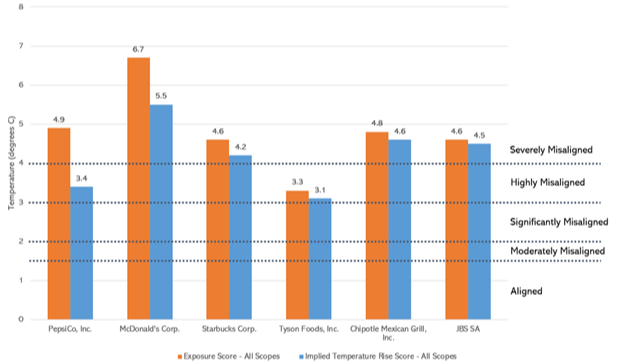
Source: Morningstar Sustainalytics. For informational purposes only.
Note: The LCTR categorizes companies according to their alignment with a 1.5 C temperature rise scenario based on their exposure score and overall implied temperature rise score.
Figure 2. LCTR Management Score
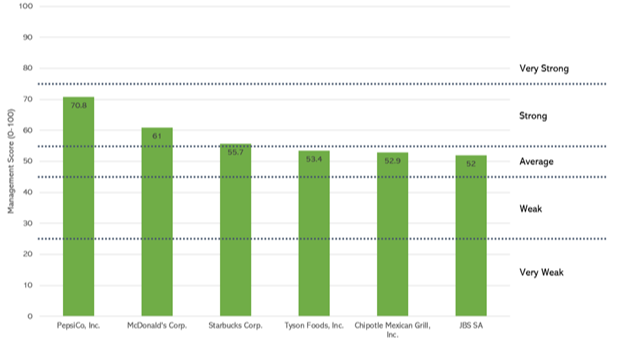
Source: Morningstar Sustainalytics. For informational purposes only.
Where Does Big Food Stand Today?
For any company to be fully aligned to net zero, its implied temperature rise must not exceed 1.5 C. Despite their pledges to be net zero by 2050, according to the LCTR, none of these six companies is doing nearly enough to reach that goal.
Table 1. Low Carbon Transition Ratings for Select Big Food Companies
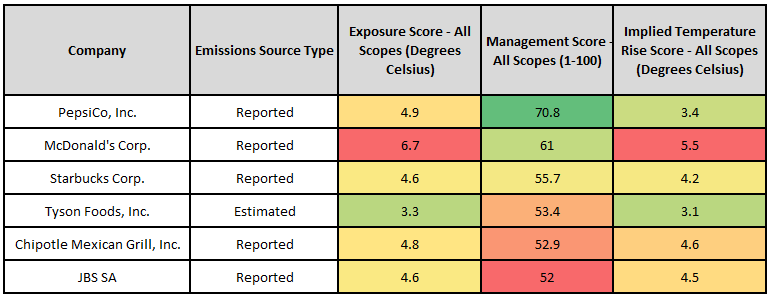
Source: Morningstar Sustainalytics. For informational purposes only.
Note: Red indicates poor performance, green indicates best performance and orange and yellow indicate average performance relative to the other companies listed in the table.
Though PepsiCo. has a high exposure score (4.9), its high management score (70.8) corresponds to an implied temperature rise of 3.4 C. With more effective management and reduction of emissions, PepsiCo. could achieve a reduction of 1.5 C. Conversely, JBS’s low management score of 52 only decreases its implied temperature rise by 0.1 C, down to 4.5 C. Notably, Tyson Foods' lower exposure score is due to the company not disclosing its scope 3 emissions. Because the other five companies disclose their scope 3 emissions, Morningstar Sustainalytics is more accurately able to determine their exposure scores.
So, why is PepsiCo’s management score so high, and what lessons can the other Big Food companies take from its approach?
Going Beyond Just Setting Targets: A Closer Look at PepsiCo
Table 2 below lists six of the indicators that go into a company’s LCTR management score, rated from 0 to 100 (higher is better). A score of 0 indicates that the company either does not have a program on that issue, does not disclose the details of its program, or its program is far below the level needed to be considered adequate. A score of 100 represents an industry-leading approach to that issue.
Table 2. LCTR Management Indicators for Select Big Food Companies
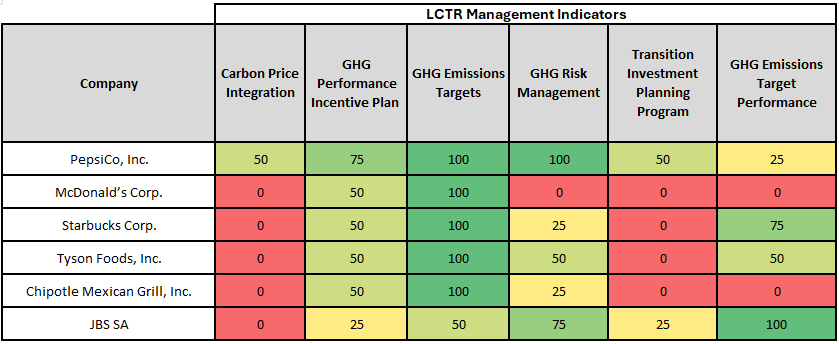
Source: Morningstar Sustainalytics. For informational purposes only.
As the New York Times article points out, each of these companies says they “aim to be net zero in their emissions by 2050,”2 often with the help of organizations like the Science Based Targets Initiative (SBTi). The scoring reflects this commitment, with five of the six companies receiving scores of 100 for greenhouse gas (GHG) emissions targets, and each company having linked its senior management’s remuneration to the achievement of GHG emission reductions. However, setting targets or incentivizing pay can be made meaningless without strategies to reduce emissions.
Of this cohort, PepsiCo has the most effective management in place to try to reach net-zero, with some remaining deficiencies. This is seen in how its many implemented strategies result in a high management score, thus leading to a large reduction in the company's implied temperature rise compared to its initial exposure score. Beyond emissions targets, PepsiCo is the only company to utilize and disclose an integrated carbon price in its strategy. PepsiCo also scores higher in GHG risk management due to its comprehensive disclosures around the PepsiCo Risk Committee. This committee reports to the board of directors on the company’s progress on risk mitigation efforts and potential supply and production disruptions due to climate change.
Other highlights of PepsiCo’s management strategies are:
- Conducting climate-related scenario analysis across its entire manufacturing footprint to locate impacts to the business related to physical and transition risks. This allows the company to identify high-risk areas and build resiliency plans.
- Closing a US$1.25 billion 10-year green bond; publishing annual green bond reports since 2019; and allocating US$974 million from the green bond issuance to eligible green projects in sustainable plastics and packaging, decarbonization of operations and supply chain, and water sustainability.
- Monitoring and engaging with suppliers on emissions related to their supply chain.
Despite these steps, PepsiCo is still sitting at an implied temperature rise of 3.4 C. What else can PepsiCo and the other five companies do to reduce their scores to 1.5 C?
Supply Chain Emissions and Other Undermanaged Risks
Supply chain emissions constitute the majority of emissions for these six food companies, and should therefore be a priority when considering how best to decarbonize their businesses. As shown in Table 3 below, many report their scope 3 emissions and have targets to reduce their supply chain emissions, but only PepsiCo currently has a reduction program in place. Still missing for PepsiCo, however, is the establishment of high-level policies and targets for board members and executives to monitor, measure, and achieve. These could help greatly reduce emissions further.
Table 3. Supply Chain Risks for Select Big Food Companies
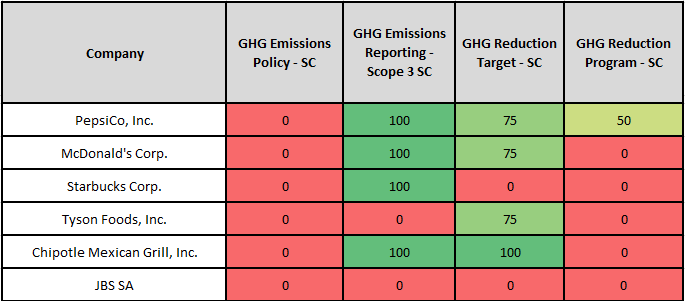
Source: Morningstar Sustainalytics. For informational purposes only.
Note: SC indicates that these indicators are specifically for a company’s approach around their supply chain.
Companies’ boards and management teams must also consider additional, more drastic options to curtail emissions if their management policies are not enough. Using low carbon fuels like biogas sourced from their own value chains or hydrogen may be required to bring emissions down.
Conclusion
While many Big Food companies are making promises about plans to become net zero by 2050, the data reveals that they are far behind. They are increasing emissions when they should be reducing them and they could do more to manage their risks. Even PepsiCo, which appears to be setting the benchmark for the industry, has glaring blind spots in its approach and thus faces major transition risks and challenges.
With these risks come opportunities. Food companies that are better positioned to reduce their emissions and lower their transition risks are also better suited to be competitive in a net-zero future.
References
- Mars Inc. is a privately held company and is thus not part of the Low Carbon Transition Ratings research universe.
- Cresswell, J. 2023. “For Many Big Food Companies, Emissions Heading in the Wrong Direction.” September 23. 2023. New York Times. https://www.nytimes.com/2023/09/22/business/food-companies-emissions-climate-pledges.html.





